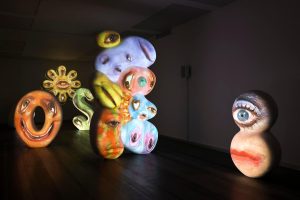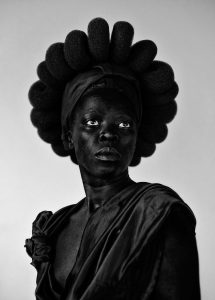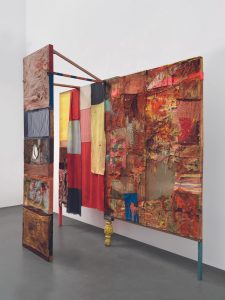Self Reflection
- Author By warden-e
- Publication date 02/11/2022
- Categories: VISUALISE [2D Creative Practices]
- No Comments on Self Reflection
After the 2 weeks I used all the pieces I made over that time and then I transformation them into an acrylic painting. I worked a lot with the Lecturer to create a freer and fluid piece and they told me about Jess Valice who creates very smooth paintings that normally focus on the ears of the person which I found really interesting.
 ntic iced etcetera, 2013
ntic iced etcetera, 2013My interest in this piece by Tony Oursler which I learnt about through my Lens and Sculpture workshop it has such a dynamic element to it all, making the object appear alive but only it is lit up clearly separating it from the rest of the space which is something I really enjoy about his work that it separates it forcing it to come alive in its own space. His work also has a really wonderful use of colour which adds a sense of magic and wonder. ‘His works evoke more of a frame of mind rather than a narrative’ (Cole, 2022) this analysis of Tony Oursler work I agree with as his work is like entering a different view on existing.

My interest in this piece by Diana Thater which I learnt about through my Lens and Sculpture workshop is an interesting use of space and scale with the projecting slightly misshapen image into a space that is typically too small for it giving it a sense of popping out at you and connecting you to it making you feel more involved with the work. The work has a sense of enveloping you inside it. ‘While the space exists in an altered state, the museum walls continue to stand tall, projectors and lengths of wire are intentionally visible.’ (Hanna, 2016) I agree with this analysis as the projections are made to be more visible, but this adds to the piece and opens the space up.

My interest in this piece by Zanele Muholi which I learnt about through my Photography workshop is unbelievably striking, with its impactful use of light, tones and texture. It’s made even more effective with the use of the grey background making the only use of white the eyes drawing you in and capturing you. One of the elements I keep getting drawn back too is the use of texture in this piece from the hair to the skin to the clothing. ‘This is an art of agency, meant to stir; this is portraiture as activism.’ (Cumming, 2020) I agree with this analysis as it forces you to see, to look and be compelled into making a stand.

My interest in this piece by Robert Rauschenberg which I learnt about through my Lens and Sculpture workshop is one that makes me feel enveloped and enclosed in the colours and textures with the breaks in the types of materials and the layered paint creates a very warming feeling when looking at the piece. ‘He threw it all onto the canvas, splashing everything with bright color’ (Small, 2017) this analysis is talking about how free he can express himself, spreading the warmth and comfort.
References
Cole, K. (2022). Being Human in Contemporary Art: Tony Oursler | Davis Publications. [online] Davisart.com. Available at: https://www.davisart.com/blogs/curators-corner/contemporary-art-tony-oursler/#:~:text=Junk%20is%20a%20biomorphic%20form%20with%20a%20projection,had%20to%20be%20view%20on%20a%20television%20monitor [Accessed 31 Oct. 2022].
Hanna, N. (2016). Diana Thater: The Sympathetic Imagination // Profile of the Artist – THE SEEN. [online] Theseenjournal.org. Available at: https://theseenjournal.org/diana-thater-sympathetic-imagination/ [Accessed 31 Oct. 2022].
Cumming, L. (2020). Zanele Muholi review – portraiture as activism. [online] the Guardian. Available at: https://www.theguardian.com/artanddesign/2020/nov/08/zanele-muholi-tate-modern-review-south-africa [Accessed 31 Oct. 2022].
Small, Z. (2017). Why Can’t the Art World Embrace Robert Rauschenberg’s Queer Community? | Artsy. [online] Artsy. Available at: https://www.artsy.net/article/artsy-editorial-art-embrace-robert-rauschenbergs-queer-community [Accessed 31 Oct. 2022].
I used my sculpture the telescope to project through using the projector. Doing this I was able to move the sculpture around and reveal or hid areas of the videos I took earlier in the week on day 1, this added to the videos creating more of an impact and adding more of a dynamic element to the sculptures.
After taking the videos I then edited them (edited versions above) on snapchat adding filters to them and removing background noise. This helped create more depth to the videos, if I was to do this again, I would make the room darker by blocking out the windows more as I would like the projection to be more of a spotlight with a high contrast.
Artists that I researched were Tony Oursler and Diana Thater for both of their interesting use of spotlighting sculptures.
Tony Oursler work also has such a dynamic element to it all, making the object appear alive but only it is lit up clearly separating it from the rest of the space which is something I really enjoy about his work that it clearly separates the sculpture and comes alive in its own space. His work also has a really wonderful use of colour which adds a sense of magic and wonder.
Diana Thater works as an interesting use of space and scale with the projecting slightly misshapen image into a space that is typically too small for it giving it a sense of popping out at you and connecting you to it making you feel more involved with the work. The work has a sense of enveloping you inside it.